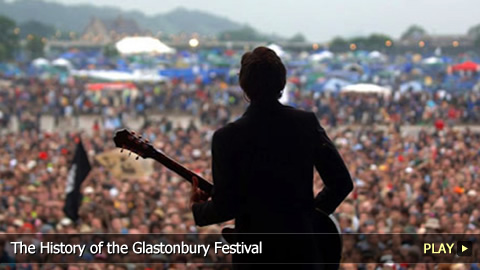The History of the Glastonbury Festival

Glastonbury Fayre
The next year, Eavis rented the farm to a group headed by Andrew Kerr that wanted to hold a free music festival based around the ethics of the hippie movement. The event stayed true to that spiritual mentality with the creation of a Pyramid stage constructed along energy lines believed to be associated with historical monuments. The festival was known as the Glastonbury Fayre, and it featured musical performances by Fairport Convention and David Bowie. Other art forms such as dance, poetry and theatre were also on display.
Glastonbury Festival and the CND
After several smaller and less organized events in the 1970s, Eavis took control of Glastonbury in 1981. The Campaign for Nuclear Disarmament’s involvement with the festival attracted politically-minded artists such as Hawkwind and New Order to play.
Donating Profits to Charity
Glastonbury became profitable for the first time that year, and this allowed Eavis to donate profits to the Peace Movement and the CND. Profits from future Glastonbury festivals were often donated to charities and other organizations.
New Sections Added
Starting in the 1980s, the festival was held annually, with a few exceptions. Several sections were added to the site, including a children’s area and the Green Fields. This spot raised awareness for environmentally-friendly causes. Notable performers during this decade were Van Morrison, The Smiths and Elvis Costello.
Expansions and Growing Attendance
Success in the 1990s allowed Glastonbury to expand further. New stages like NME and Avalon were added, along with places for a circus, cinema and cabaret. The number of festival-goers also increased, though this was partly due to gate-crashers who jumped the fences to gain free access.
Police Issues and Bad Weather
The 1990 edition was the biggest festival yet. However, it ended with a clash between police and some New Age festival-goers who were accustomed to the relaxed and loosely organized feel of the related Solstice festival at Stonehenge. Heavy rains towards the end of the decade filled the site with mud, and in 1998 prompted the introduction of mud surfing.
Notable Acts and Charitable Organizations
The 90s saw headliners such as The Prodigy, The Cure and R.E.M. as well as notable acts like Oasis, Rage against the Machine and Jeff Buckley. Oxfam and Greenpeace were two organizations that benefitted from significant donations during this time.
Fence-Jumpers and Sold Out Crowds
Thanks to an increase in fence-jumpers, Glastonbury saw its biggest attendance rate during the next decade. The organizers attempted to curb this by installing a new fence. Many of that decade’s festivals sold out very quickly, and this caused a storm in 2004 when fans could not purchase tickets due to overloaded phone lines and websites.
Headliners and Controversy
During this period, artists like Lady Gaga, Bruce Springsteen and Paul McCartney took to the stage while bands like Muse, Coldplay and Radiohead also performed. In 2008, controversy arose when hip-hop artist Jay-Z was announced as a main headliner. The next decade opened with sets by Stevie Wonder, Beyoncé and U2.
Evolution
Throughout its existence, the Glastonbury Festival has undoubtedly evolved. While its location has never moved from southwest England, the site became more highly secured and organized. Though the Pyramid and Other stages are the main performance spots, there are several other stages, and some of these are not managed by the festival but by outside organizations.
More Attractions
The festival came to include many more attractions to entertain attendees, such as the comedy, acoustic, and dance music tents. Volunteers played an important part, as they ran most aspects of the event, excluding technical and security duties.
Camping
The atmosphere of Glastonbury was influenced by the fact that concert-goers often camped near the site, since the festival spans several days.
The Glastonbury Festival has raised millions for multiple causes. However, the event is most well-known for showcasing contemporary music and many other performing arts, and this has ingrained it into the pop culture of our day.


 0
0
 0
0
 flagged
flagged